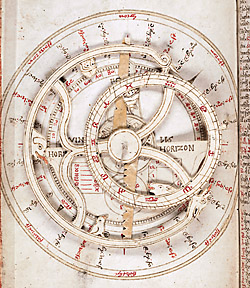 | This is a detail from a 16th-century book of astronomical and astrological treatises that is on view in the Beinecke Library exhibit. |
In 1604, explorer and navigator George Waymouth set out to win the King of
England’s favor — and support for a new voyage to the American
coast — by presenting the monarch with a manuscript of Waymouth’s
elaborate illustrations of the mathematical instruments then in use on the
battlefields of Europe, in navigation at sea and in the houses of practitioners
of the new science
T H I S
Exhibit reveals the ways in which mathematics was practiced in England 400-500 years ago
That manuscript, titled “Jewell of Artes,” now bound in royal arms,
is one of the works featured in a new exhibition that opens this month at the
Beinecke Rare Book and Manuscript Library.
Titled “The Reckoner’s Art: Reading and Writing Mathematics in
Early Modern England,” the show documents how mathematics was read, written,
learned, practiced and used in 16th- and 17th-century England. It will be on
view Jan. 16-April 16.
The first mathematical textbook written in English was published by Robert
Record in 1542. By the end of the 17th century, young boys and girls of the
gentry practiced arithmetical word problems in the same notebooks in which
they practiced their handwriting. Amateurs like Samuel Pepys or Robert Burton
took up the study of mathematics as a hobby, reading books and using instruments
like compasses and quadrants, maps and charts. The shelves of a London bookseller
might be stuffed with works on arithmetic and geometry, mathematical puzzles,
the making of mathematical instruments, and the uses of mathematics in astronomy,
cartography, gunnery, navigation or accounting.
Mathematics was used on the battlefield by gunners, engineers and surveyors;
at sea, by navigators and pilots; in property management, by estate owners
and cartographers; and in trade, by merchants and clerks deciphering the complexities
of currencies, weights and volumes. By the early 18th century, mathematician
and scientist Isaac Newton had become an English national hero, prompting Alexander
Pope to write his couplet that “God said ‘Let Newton be!’ and
all was light.”
Mathematics was also an important part of daily life. The 1604 Book of Common
Prayer, for example, included a calendar for the reading of the psalms, a table
outlining the “golden number” with which the reader could “finde
Easter for ever” and a 39-year “almanacke” for the dating
of the Church holidays, which also recorded the number of lunar days as well
as the hour of sunrise and sunset. Popular almanacs and calendars recorded
the dates of court and university sessions, of yearly events, and of the rising
and setting of the moon, ensuring that business transactions could be predicted
and conducted.
In addition to “Jewell of Artes” (which, incidentally, won Waymouth
funding for his next and final voyage to America), the Beinecke Library exhibition
features materials that document the hours, sums, debts and numbers by which
the readers and owners of almanacs and other works jotted, counted, noted and
organized their daily lives. These include account books and ledgers documenting
the business of estates and trades; templates for the instruction of clerks
on the correct format of receipts and bills; and notebooks or commonplace books
in which readers scribbled important transactions on margins or on pages between
copied excerpts from classical authors or English poets.
The Beinecke Rare Book and Manuscript Library is located at 121 Wall St. It
is open for exhibition viewing 8:30 a.m.-8 p.m. Monday-Thursday; 8:30 a.m.-5 p.m. Friday; and 10 a.m.-5 p.m. Saturday.
Admission is free. For further information, call (203) 432-2977 or visit the
website at www.library.yale.edu/beinecke. W E E K ' S
W E E K ' S S T O R I E S
S T O R I E S![]()
 University is increasing payout from endowment
University is increasing payout from endowment![]()
![]()
 Stern named to third term as dean of School of Architecture
Stern named to third term as dean of School of Architecture![]()
![]()
 Findings set stage for prevention of epilepsy
Findings set stage for prevention of epilepsy![]()
![]()
 Antibody may delay development of diabetes
Antibody may delay development of diabetes![]()
![]()
 Scientists determine intricate process used in assembly . . .
Scientists determine intricate process used in assembly . . .![]()
![]()
 Mutant gene identified as ‘villain’ in hardening of the arteries
Mutant gene identified as ‘villain’ in hardening of the arteries![]()
![]()
 Researchers find gene that protects newborns . . .
Researchers find gene that protects newborns . . .![]()
![]()
 Yale Rep stages the world premiere of ‘The Evildoers’
Yale Rep stages the world premiere of ‘The Evildoers’![]()
![]()
 Exhibit reveals the ways in which mathematics . . .
Exhibit reveals the ways in which mathematics . . .![]()
![]()
 Advocates for universal preschools win Grawemeyer Award . . .
Advocates for universal preschools win Grawemeyer Award . . .![]()
![]()
 Two medical school researchers win awards . . .
Two medical school researchers win awards . . .![]()
![]()
 Lewis Walpole Library celebrates re-opening with exhibition
Lewis Walpole Library celebrates re-opening with exhibition![]()
![]()
 Peabody to honor Martin Luther King Jr.’s legacy with festival
Peabody to honor Martin Luther King Jr.’s legacy with festival![]()
![]()
 Stanton Wheeler, was musician, master, sociologist and sports fan
Stanton Wheeler, was musician, master, sociologist and sports fan![]()
![]()
 Change of venue for Waith memorial
Change of venue for Waith memorial![]()
![]()
 Campus Notes
Campus Notes![]()
Bulletin Home |
| Visiting on Campus
Visiting on Campus |
| Calendar of Events
Calendar of Events |
| In the News
In the News![]()
Bulletin Board |
| Classified Ads
Classified Ads |
| Search Archives
Search Archives |
| Deadlines
Deadlines![]()
Bulletin Staff |
| Public Affairs
Public Affairs |
| News Releases
News Releases |
| E-Mail Us
E-Mail Us |
| Yale Home
Yale Home